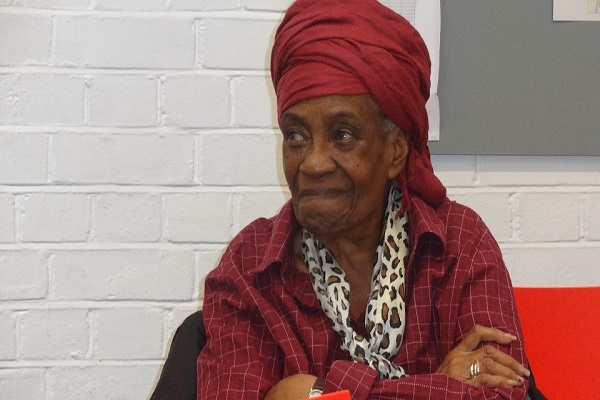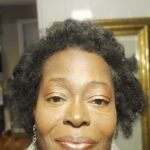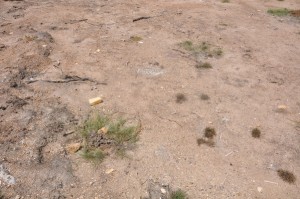Early Life
Born in 1927, in Suriname, South America, Petronella came from a mixed cultural (Creole) background based in African, Asian and Dutch (white) heritage. However, she was raised in an extremely complex society. On one side, was Catholicism, which included a convent school education, and on the other side, she was the beloved niece of a childless high priestess of the Beekhuize assembly of the Winti religion, and Nenedofi of the Lakoe Society. Winti, an African-Surinamese religious belief was a fusion of different African religions that enslaved Afrikans took to Suriname.
The sparks that ignited Petronella’s writing career began in Catholic school when she won her first writing prize, when she was eight years old. Her second prize came about after an unexpected turn of events, while attending a fee paying high-school for predominantly white middle-class girls. During an inter-school writing competition, groups of girls from each school were selected to write a play. The young Petronella, decided to recreate a Lakoe play. Lakoe is traditionally an open air play, where the roles are predominantly played by women, with men taking part in the drumming and setting up of props. It tells the story about the first mixed race child and was usually performed by generations of the same families. The story also related the background history of enslaved Afrikan women and the perilous journey that they were forced to make from Afrika, highlighting their strength and determination.
However, the play lost in favour of a story about the culture and princesses of Holland. Because they didn’t win, Petronella was beaten up by a group of girls for causing their school to lose. “You and your negerachtig (niggeries) play,” they hissed as they set upon her. Her second prize came about because of that incident. A rich person heard that she had been assaulted and paid for her to have an extra year at an elite school, in addition to other prizes. That play was later published in Dutch in 1983, as: De winst van het Lakoe-spel (The win of the Lakoe game), and was semi-autobiographical. Aimed at a young reading audience, it was first written in English. However, no English publisher wanted to publish it, because in those days, Black writers were encouraged to write about racism and migration. “That was what was expected of Black authors from publishers; certainly not stories about goddess’ and Lakoe dance,” recounted Petronella.
Petronella left Suriname in 1947, to emigrate to Guyana, where she lived with her husband and two young sons, both of whom were born there. While in Guyana, she became a member of the Red Cross and through that organisation, enrolled on many courses, and also trained to become a teacher. She was also very active in supporting individuals from her local community. Her arrival in England in 1961, did not provide the happy ending that most migrant women who came to join their husband’s had dreamt of. And like so many others, she found herself alone with two young children depending on her and no with family for support.
She eventually found accommodation in a dank basement, in the deprived Borough of Hackney. Alone and in the dark, she was reminded of stories that she had read by Charles Dickens. This influenced her to write to the Sunday Times newspaper about the conditions that she saw around her: the disused railway that was home to rats scurrying for food and who seemed to have no fear of humans, the neglected Regents Canal, with its stagnant and foul smelling water, and the poverty experienced by most of the residents.
Also, some local children supplemented their incomes by stealing food and other goods from the local market stalls, and were often hotly pursued by the stall holders. All of these things reminded her of the Dickensian England of Oliver Twist. That article was published as a long letter, however, the editor ridiculed her writing and ended by saying that she needed to improve on her English grammar. Instead of being deterred by the insult that it obviously was, she took the editor’s advice and enrolled in a creative class at the City Literature Institute. There, she met author, poet and playwright, Maureen Duffy who was her tutor, and who became her mentor and good friend. It was Maureen Duffy who trained her and edited her work in the beginning, because English was Petronella’s third language; Dutch being the official language in Suriname, while Sranan was the language of the people.
Educational Career
In England, she gained a GCE in Dutch in 1964, then a diploma in English as a foreign language in 1965. She later received a BA. Hons in education and in 1984, completed her PhD in: Exploring Failure in Language and Education.
Petronella, a trained linguist, was also a research fellow at the department of linguistics at the University of Sheffield. After being made an honorary fellow of the linguistics department, multilingual Petronella started work in the community, exploring the language and dialect of the people of Sheffield. She looked at language fusion and how the language developed from a predominantly Guyanese community mixing with the local community. As a result of those links, she encouraged people from the Caribbean and other locals, mainly women, into higher education via a programme of study developed for students aged 21, and over. The programme called MAP (Mature Student Programme) helped some members to go onto university, and to some achieving a Master’s degree.
During that time, the Afrikan-Caribbean organisation met in a dilapidated old school building for activities. Petronella set up workshops and courses in languages as well as English and Caribbean history. Because of the state of the building; she and members of the organisation got together and raised funds for a centre that came to be named, Sheffield and District African and Caribbean Centre (SADACCA). Because of her tireless efforts to help people to get into higher education, more funds were raised and a student hostel was built and named, Doctor Breinburg Court.
Between 1986, and 1989, Petronella, in conjunction with Plan Hill High School, developed a research project that involved schools, academics and members of the local community. The learning package she produced was called the British Caribbean Link and was a series of resources that was used by teachers and pupils. In 1989, she left Sheffield and returned to take up an appointment at Goldsmiths’ University of London, where she was appointed to set up Caribbean Studies across the University. In her role as senior lecturer and head of the Caribbean Centre, Petronella travelled to many European countries, including: Belgium, Germany, Poland and Sweden. She also travelled to Sint Maarten, Brazil, Guyana, Venezuela and Jamaica, to present papers on linguistics and papers in relation to education and culture. She also had special academic links with Mona campus, and St. Augustine campus, both parts of the University of the West Indies (UWI) in Jamaica and Trinidad &Tobago. Through her connections in Amsterdam, a group of her students were able to visit during a cultural exchange programme. She also developed courses for BA and MA students.
Petronella and I met while we were walking along a corridor at Goldsmiths’. However, I was acquainted with her books long before she met me: I was one of those parents who eagerly read her stories to my young children; I wanted them to develop self-love and a love of reading, and the storylines, along with the illustrations, did just that! And because of my interest in books, I decided that for one of my placements, I would ask to work alongside her at the Caribbean Centre. She taught me many things including the Dewey System, a method of cataloguing the books that she had bought to set up the Caribbean Centre. She had innumerable books that were written by Caribbean writers and I tapped into that knowledge as I helped with the cataloguing. Prior to that, my only exposure to Black writers had been books written by Afrikan-Americans; I didn’t know that Caribbean writers existed. But once I started reading Caribbean authors, I realised that they validated my cultural experiences more than the Afrikan-American books that I had read. She had many colleagues and friends who were also academics of Afrikan-Caribbean descent. And for me that meant that there was always a continual input of expert knowledge from an Afrikan-Caribbean perspective and through her, I gained access to many of them. I was only supposed to work one term with her; however, I loved it so much that I committed myself to doing two more terms.
After finishing university, and giving birth to my last child, there was still work to be done at the Caribbean Centre. So once or twice a week, I took my daughter in with me because I was breastfeeding. When she fell asleep, I put her in her Moses basket, placed her under the table, and continued with whatever needed to be done. By that time the Caribbean Centre had moved and was now in one of the faculty buildings in St. Donatts Road, New Cross. I also attended many of the courses that she had devised and before long, she had me running a taster course in Socio-Linguistics. I also worked with older people in a reminiscence class. I enrolled on one of the courses she set up, and gained a university qualification in English with Caribbean Studies. Later, when she set up Caribbean Communities in Europe (CACOEU), I eventually became the editor of CACOEU TALK, a journal that had contributions from both academics and members of the community and which served to inform and educate its readers on different subjects.
Petronella was all inclusive when it came to people, and she worked with all age groups: from primary school, right through to people of retirement age. She was a long standing member of Writers Guild of Great Britain and Fellow of the Royal Geographical Society (with IBG). Her literary works include a long list of scholastic papers and children’s literature and she also had short stories published in anthologies. She penned two young people’s novels: Us boys of West Croft (1975), another semi-autobiographical novel, that was later translated into Danish, and De winst van het Lakoe-spel. She also wrote plays that were performed in schools and in theatre-in-education. In 2005, she embarked on her first adult novel, Instead of Roses and Rings. The same year, she was awarded a life-long achievement award, in recognition for her contribution to children’s literature, from KWAKOE forum in Amsterdam. in 2011, she wrote her third adult novel, Goodasyu: Crescendo; the title coming out of a conversation that we had, and for which, I was commissioned to take the photograph for the front cover.
Petronella Breinburg was an academic, educator, linguist, author, and poet. She was also a trailblazer in her stories that reflected young Black children. Her stories were written at a time when morale was especially low among black parents, who were becoming increasingly aware of how children were excluded and alienated in mainstream schools. Petronella was criticised for not wanting to write about racism and decades later, the same cry was echoed by another successful Black author, Malorie Blackman.
It seems as though Black authors are pigeon-holed and expected only to write about things that affect them negatively, which is a somewhat one dimensional view for publishers to take. The 1970’s were much harder for Black writers; however, she broke through that glass ceiling, paving the way to others. Yet today, only 7.64% of books are penned by Black authors and only 12.12% of those books are about Afrikan or Caribbean children. (https://wordsrated.com/representation-childrens-literature/). Why then, over fifty years later, are so many publishers still unwilling to publish books that reflect diversity?





1 comment
I enjoy the article I was happy you can listen to the article. Very well written and she have done her research